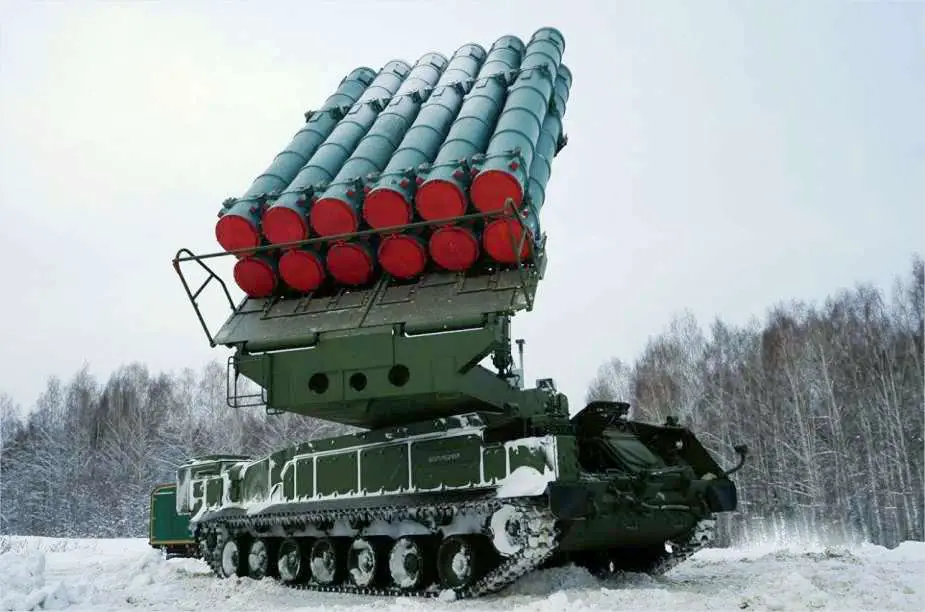- Army
- Conflicts in the world
- Israel - Iran conflict 2025
- Pakistan - India Conflict 2025
- Russia Ukraine War 2022
- Libya conflict day by day
- HAMAS - Israel War 2023
- Operation Serval in Mali French Army
- Sangaris operation Central African Republic
- Sangaris opération militaire République Centreafrique
- Ukraine - Russia conflict
- Syria conflict news
- Defence & Security Industry Technology
- Armies in the world
- Analysis Defense and Security Industry
- Conflicts in the world
- Navy
- Air
Russia claims that Buk-M3 air defense system proves effective against Ukrainian aerial threats
On January 3, 2023, the Russian Ministry of Defense released information regarding the operational performance of the Buk-M3 air defense system, also referred to as the Viking, during its deployment in Ukraine. The Buk-M3, categorized as an advanced medium-range air defense missile system, was utilized to address various aerial threats, including those originating from Western-supplied weaponry.
Follow Army Recognition on Google News at this link

A single Buk-M3 system, comprised of several launch vehicles, can simultaneously engage up to 36 different targets from any angle. (Picture source: Yandex)
Anti-aircraft gunner Alexey provided insights into the system's capabilities, highlighting its ability to detect aerial threats at altitudes ranging from 8 meters to 25 kilometers. Moreover, it can engage air targets effectively within a range of 3 kilometers up to 71 kilometers. This capacity provides Russian forces with valuable data to make tactical decisions in response to potential threats.
Russian reports indicate that Russian operators of the Buk-M3 system effectively intercepted and neutralized various aerial threats during their deployment in Ukraine. These threats encompassed high and medium-altitude challenges, including modified S-200 missiles and M142 HIMARS rockets, with interceptions occurring at altitudes ranging between 10,000 to 15,500 meters.
The deployment of the Buk-M3 in Ukraine offers several strategic advantages for the Russian Armed Forces. It signifies an improvement over older systems, enhancing Russia's capability to intercept various Ukrainian targets, including aircraft, cruise missiles, and drones. The system's extended range and improved targeting accuracy expand the Russian defensive perimeter, while its mobility facilitates rapid redeployment to protect different areas. Moreover, its resistance to electronic countermeasures presents challenges to potential Ukrainian attempts to disrupt the system's functionality, a tactic previously used against Russian military assets, thereby contributing to its effectiveness.
The Buk-M3's ability to integrate with other Russian defense systems, such as the Pantsir-S1, contributes to an overall strengthening of Russia's defensive capabilities, creating a more responsive and adaptable air defense network. By effectively safeguarding critical areas and assets in this manner, the Buk-M3 can serve as a force multiplier, optimizing resource allocation and personnel deployment.
The Russian Buk-M3 Viking surface-to-air missile system stands as the latest generation of Russian medium-range surface-to-air missile systems. It is equipped with advanced electronic components and a new missile, providing improved performance compared to older Buk systems and even surpassing the capabilities of the S-300P long-range air defense system.
A single Buk-M3 system, comprised of several launch vehicles, can simultaneously engage up to 36 different targets from any angle. Furthermore, a single 9S36M fire-control radar can support the engagement of up to six different targets concurrently within a 120° azimuth and 85° elevation sector.
The Buk-M3 Viking missile battery consists of two TELAR 9A317M (Transporter Erector Launcher and Radar) and one TEL 9A316M (Transporter Erector Launcher) vehicle, all mounted on a GM-569 tracked armored chassis. The TELAR carries six ready-to-fire missiles on a turntable that can traverse a full 360°. Armed with advanced radar-guided surface-to-air missiles, the Buk-M3 boasts a target-destruction probability surpassing 98% and a maximum destruction range extended by 25 kilometers compared to older Buk systems.
The Buk-M3 can engage air targets at ranges spanning from 2.5 to 70 kilometers, with speeds of up to 3,000 m/s and altitudes from 15 meters to 35 kilometers. While optimized for intercepting low-flying cruise missiles, it can also engage ground and sea targets. Furthermore, as reported by Army Recognition on April 19, 2021, the effectiveness of the Buk-M3 is further enhanced by its integration with the Igla (NATO reporting name: SA-18 Grouse) man-portable air defense systems (MANPADS).


























